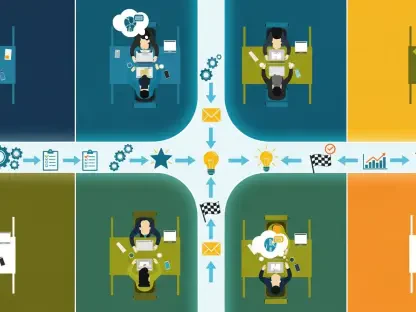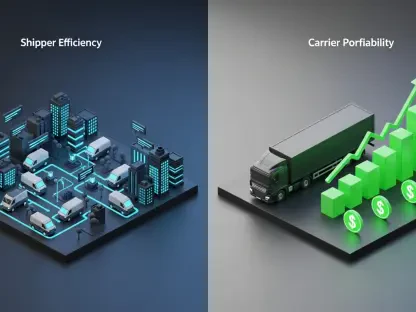Introduction to HR’s Transformative Role
In an era where technological advancements reshape industries overnight, Human Resources (HR) stands at the forefront of guiding organizations through unprecedented change, particularly with the rise of Artificial Intelligence (AI). The challenge lies in balancing rapid innovation with the human element, ensuring that employees remain engaged and adaptable. HR has evolved from a support function to a strategic driver, tasked with leading transformation in a landscape marked by uncertainty and shifting skill demands.
This pivotal role requires HR to proactively shape the workplace rather than merely respond to external pressures. By embracing technology and reinforcing cultural foundations, HR can create an environment where change is not feared but welcomed. The focus areas for this transformation include leveraging organizational culture as a stabilizing force, normalizing AI usage to reduce apprehension, and empowering employees through innovative tools to enhance productivity.
A comprehensive approach to these elements positions HR as the architect of sustainable progress. This guide explores how HR can lead with confidence, blending AI integration with cultural strategies to foster resilience and innovation across all levels of an organization.
Why HR Must Lead with AI and Culture
Amid technological disruption and evolving workplace dynamics, HR emerges as the critical force to navigate uncertainty and align organizational goals with employee needs. The integration of AI, coupled with shifting skill requirements, demands a leadership approach that prioritizes both innovation and stability. HR’s unique position allows it to bridge the gap between technological advancements and human priorities, ensuring a seamless transition during turbulent times.
Leading in this space offers significant benefits, such as heightened employee engagement and minimized resistance to change. When HR champions transformation, it cultivates trust by addressing concerns and demonstrating the value of new tools like AI. This proactive stance also helps preserve organizational identity, preventing cultural erosion amid rapid shifts and fostering a sense of continuity for teams.
A people-centric strategy, paired with strategic AI adoption, builds resilience and sparks creativity within the workforce. By focusing on employee well-being alongside technological progress, HR can mitigate fears of displacement and instead highlight opportunities for growth. This balanced approach ensures that transformation strengthens the organization without sacrificing its core values or human capital.
Key Strategies for HR-Led Transformation
To effectively drive change, HR must adopt actionable strategies that address both cultural and technological dimensions of the workplace. These approaches should be rooted in fostering trust, encouraging adaptability, and aligning innovation with organizational purpose. The following sections detail three core strategies to guide HR in leading transformation, supported by practical insights and real-world examples.
Each strategy offers a blueprint for implementation, ensuring that HR professionals can apply these principles in diverse organizational contexts. From reinforcing cultural anchors to embracing AI as a tool for empowerment, these methods provide a roadmap for sustainable change. The emphasis remains on creating an environment where employees feel supported and inspired to contribute to the evolving workplace.
Reinforcing Culture as an Anchor
Organizational culture, encompassing mission, vision, and values, serves as a vital foundation during periods of change, and HR plays a central role in reinforcing these elements. By anchoring employees in familiar principles, HR can alleviate the stress associated with technological shifts and restructuring. This strategy involves embedding cultural tenets into daily operations, ensuring that they remain a touchstone for decision-making and behavior.
Consistent communication about enduring workplace aspects is essential to maintain morale and reduce anxiety among staff. HR can achieve this by regularly highlighting the organization’s purpose and celebrating shared achievements that reflect core values. Such efforts remind employees of their collective identity, providing stability even as job roles and processes evolve with AI integration.
Case Study: LinkedIn’s Cultural Reinforcement
A notable example of this approach comes from LinkedIn, where the HR team prioritizes core values to ground employees amid AI-driven changes. By emphasizing continuity in purpose, LinkedIn ensures that staff remain connected to the organization’s mission, even as new technologies reshape workflows. This focus on cultural reinforcement helps employees navigate transformation with a clear sense of direction and belonging.
Normalizing AI in the Workplace
Reducing the stigma surrounding AI is a critical step for HR in fostering a forward-thinking workplace. By creating an open environment where employees can explore AI tools without fear of judgment, HR can demystify the technology and encourage widespread adoption. This involves shifting perceptions from viewing AI as a threat to recognizing it as a valuable asset for efficiency and innovation.
Practical steps to normalize AI include hosting workshops focused on AI applications, sharing success stories of early adopters, and integrating AI fluency programs across all levels of the organization. These initiatives build confidence by demonstrating tangible benefits and providing hands-on experience. HR can further support this by establishing safe spaces for experimentation, where mistakes are seen as learning opportunities rather than setbacks.
Example: LinkedIn’s “Plai Dates” and “Human+ Launchpad”
LinkedIn exemplifies this strategy through innovative programs like “Plai Dates,” where HR teams collaborate to share AI tips and experiences, fostering a culture of learning. Additionally, the “Human+ Launchpad” initiative promotes AI experimentation across the company with demos, hackathons, and rewards for “AI Pioneers.” These efforts underscore the importance of a human-AI partnership, positioning technology as a complement to human skills rather than a replacement.
Empowering Employees Through AI
AI holds immense potential to empower employees by automating repetitive tasks, allowing them to focus on higher-value, meaningful work, and HR must champion this narrative. By reframing AI as a tool for enhancement rather than disruption, HR can inspire staff to reimagine their roles and contribute more strategically to organizational goals. This shift in perspective transforms apprehension into excitement for new possibilities.
Effective communication is key to highlighting AI’s benefits and dispelling fears of job displacement. HR can facilitate this by showcasing how automation frees up time for creative problem-solving and personal growth. Training programs that emphasize skill development alongside AI use further reinforce the idea that technology serves as an enabler, equipping employees to add greater value to their teams.
Real-World Impact: AI as a Catalyst for Growth
LinkedIn’s approach provides a compelling illustration of AI empowerment, as it encourages employees to take ownership of their evolving roles through technology. By integrating AI tools, staff are enabled to dream bigger, tackling complex challenges with newfound efficiency. This strategy not only boosts individual contributions but also drives collective progress, aligning personal and organizational aspirations.
Conclusion: HR as the Future of Work Architect
Reflecting on the journey of transformation, HR has proven to be a cornerstone in blending cultural strategies with AI integration, crafting a resilient workplace. The path taken demonstrated that by anchoring in core values, normalizing technology, and empowering employees, HR can steer organizations through complex changes with confidence. This leadership has shaped environments where innovation thrives alongside human priorities.
Looking ahead, HR leaders are encouraged to adopt these best practices by starting with small, measurable initiatives, such as pilot AI programs or culture workshops, to build momentum. A focus on transparency and ethical AI use emerges as a critical next step, ensuring trust remains at the heart of transformation efforts. These actions promise to sustain progress while addressing potential challenges before they escalate.
Ultimately, the benefits of HR’s strategic role touch organizations seeking adaptability, employees embracing change, and leaders aiming for long-term growth. Prioritizing ongoing training and open dialogue becomes an essential consideration to maintain alignment. This forward-thinking approach positions HR not just as a responder but as a visionary architect of the future of work, ready to tackle emerging trends with agility.









